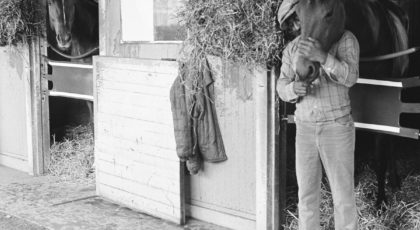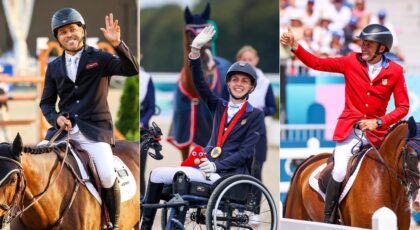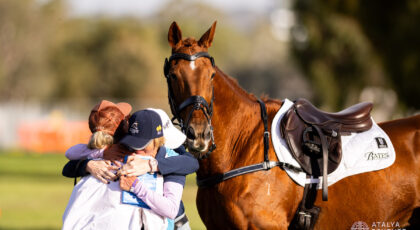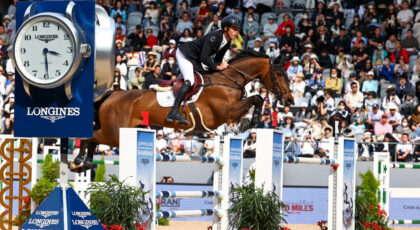Intrinsic motivation is an ongoing discussion within the horse training community, particularly among positive reinforcement-based trainers.
The idea that horses can experience intrinsic motivations and flow states similar to humans is an important part of the Intrinzen training philosophy, for example. Unfortunately, intrinsic motivation has barely been studied in animals, so there is almost no empirical research to fall back upon.
However, this may soon change.
In their brand new paper Animals in flow – towards the scientific study of intrinsic reward in animals, Sara Hintze and Jason R. Yee propose ways to study flow and intrinsic motivation in non-human animals. They state bluntly that “the near-complete abstention from acknowledging the potential for intrinsic motivation in animals has left the field in a state of arrested development,” and make a strong case for the fact that better understanding of these concepts can have a major welfare impact.
Flow and intrinsic motivation in humans
‘Flow’ is a fairly well-defined concept in human studies, and essentially describes a state of total absorption in a task, where the person is resistant to distractions and doesn’t notice the passing of time. To achieve flow, your level of skill needs to perfectly match the challenge of the task. If it’s too easy, you’ll become bored, and if it’s too difficult, you will become frustrated and anxious. The graph below, taken from Hintze’s and Yee’s paper, illustrates the idea.
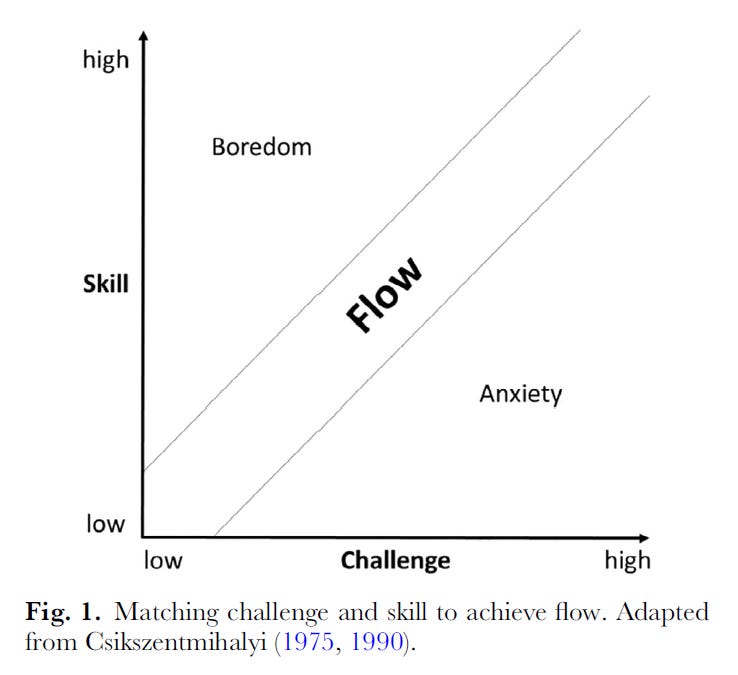
There are two types of motivation that drive behavior: intrinsic motivation, where performing the behavior is rewarding in and of itself, and extrinsic motivation, where the behavior is performed to achieve a particular goal. A prerequisite for achieving flow is intrinsic motivation, meaning the task is done purely for the enjoyment of doing it.
The neurobiology of intrinsic and extrinsic motivation is slightly different. While both are associated with activity in the striatum, the part of the brain associated with rewards, intrinsic motivation is also associated with activity in the anterior insular cortex, which seems to play a role in feelings of satisfaction. In human studies, performing intrinsically motivated behaviors is reported to improve general well-being to a greater extent than performing extrinsically motivated behaviors.
Flow and intrinsic motivation in animals
In terms of non-human animals, extrinsic motivations are fairly straight-forward and form the basis of operant conditioning: avoiding unpleasant things (negative reinforcement/positive punishment) and acquiring pleasant things (positive reinforcement/negative punishment).
Intrinsic motivations can be more difficult to identify. Hintze and Yee give examples of previously established concepts where this type of motivation may be at work, and which could provide a biological basis for studying flow in animals:
- Play
- Curiosity – information-seeking
- Agency and competence – active engagement with the environment in order to gather knowledge and skills for future challenges
- Effectiveness – the need to be successful in achieving desirable outcomes, understanding the environment, and having control over it
- Contrafreeloading – the phenomenon that animals will work for a certain resource even when that same resource is freely available
- Eureka! moment – suddenly finding the solution to a difficult problem (in human-horse interactions, for example, this can happen during training when the horse trials the correct response to a cue and connects behavior and consequence)
Studying flow in animals
Hintze and Yee make the argument that each of the above concepts contain elements that are relevant to entering a flow state, and could be used to design appropriate experiments. Any experimental design would have to consider species-specific behaviors, cognitive abilities, whether they are predator or prey, whether they are neophilic or neophobic, natural levels of physical activity, individual age and sex differences, and so on.
In addition to experimental design, a major challenge when testing flow in animals is that they can’t tell us about their experience. Subjective reporting is an important part of human flow research, but that obviously lies beyond the capabilities of animals. Hintze and Yee propose using a variety of behavioral tests to assess the two main aspects of flow, resistance to distractions and distortion of time.
Being in a flow state has a positive effect on mood in humans, so Hintze and Yee also suggest using behavioral tests to assess an individual animal’s optimism and pessimism.
What if it’s not flow?
Hintze and Yee bring up a number of potential limitations to studying flow in animals, notably other psychological states that can lead to similar behaviors, such as stereotypies and obsessions. They also caution that many domesticated animals live in chronically stressful environments, which can make them less motivated to engage with a potentially flow-inducing task. Severe chronic stress can lead to depression-like states, inhibiting any intrinsic motivation.
I would like to add habituation and learned responses to this list of differential mechanisms. Over the course of repetition, many behaviors become habitual in certain contexts. Take the classic example of a horse that keeps jumping obstacles even after the rider has fallen off (here’s an example). On the surface, this is frequently interpreted as a horse that “loves” to jump – i.e. is intrinsically motivated to perform the behavior.
However, it’s most likely simply a learned behavior, where the presence of obstacles in an arena has become a contextual cue for the horse to jump them. As many horses are corrected for refusing or evading, they have been taught that the only option when faced with an obstacle is to go over it, and any independent decision-making is removed out of the equation.
Another important thing to consider is the fact that entering flow states may not be equally relevant for all species. For a predator, finding stalking and hunting intrinsically rewarding could make it more resilient (for tigers, something like 90-95% of hunts end in failure, so extrinsic rewards likely play only a small part in their motivation).
For a prey animal like the horse, however, being totally absorbed in an activity to the point of not being attentive to its environment is likely going to get it killed by above-mentioned predator. It’s therefore entirely plausible that there are evolutionary species differences in ability to enter flow states.
Why does flow matter?
As Hintze and Yee point out in their paper, allowing animals to engage in intrinsically rewarding activities can improve their overall emotional well-being. If we can identify tasks that induce flow states, we may then be able to design species-appropriate enrichment activities to improve welfare.
I would like to add that understanding the relationship between skill, challenge and the horse’s emotional experience—boredom if it’s too easy and frustration/anxiety if it’s too hard—can have a big impact on the quality of our training. Finding an appropriate balance between what we ask the horse to do and what the horse can do will have an impact on both training progress and behavior, irrespective of whether the horse enters into a flow state or not.
In summary, Hintze and Yee make a good case for studying intrinsic motivation and flow states in non-human animals. While there are a number of concepts in animal behavior that share overlapping elements with flow, there is always cause to be a bit cautious when extrapolating human studies to animals, at least until we have a better understanding of how intrinsic motivation manifests in animals and potential species differences.
Full reference: Hintze, S., Yee, J.R. 2022. Animals in flow – towards the scientific study of intrinsic reward in animals. Biological Reviews. https://doi.org/10.1111/brv.12930


 April 14, 2023
April 14, 2023 















